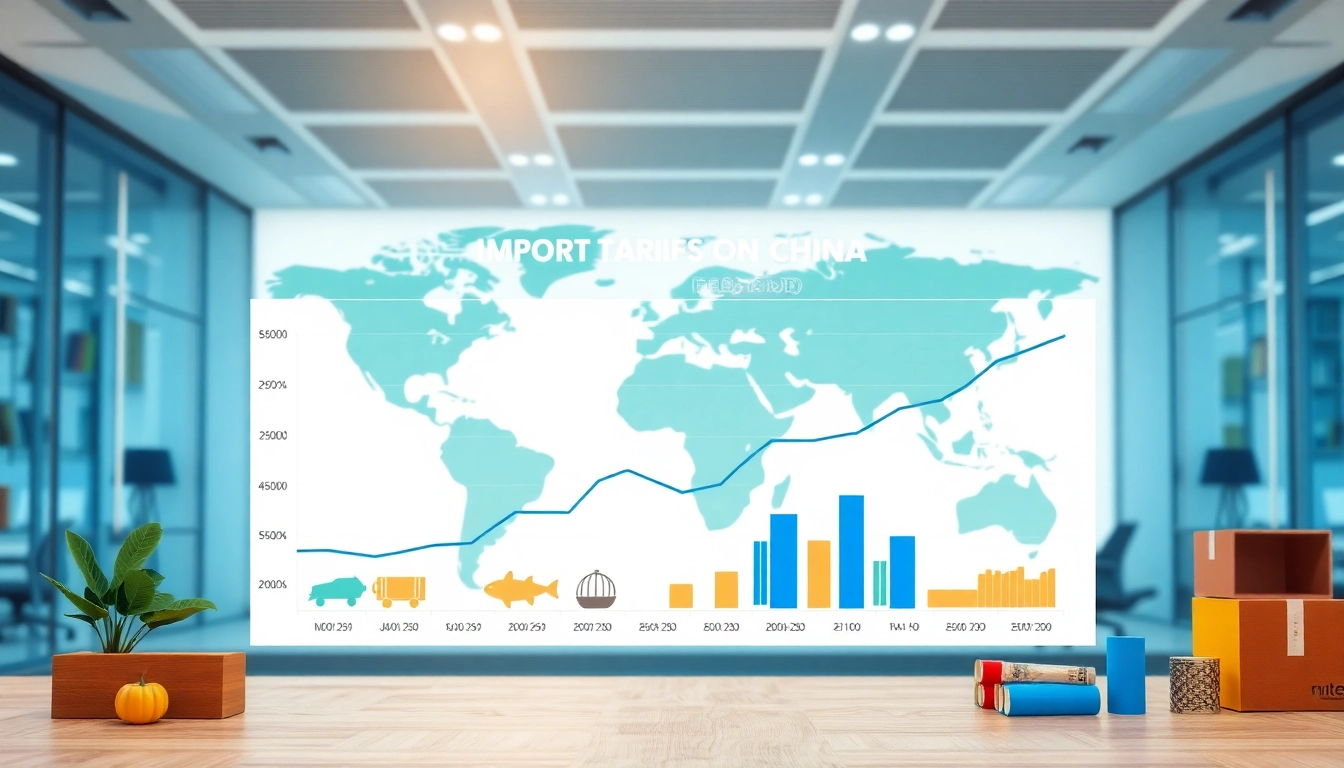
Overview of Import Tariffs on China
As global trade dynamics continually evolve, the subject of import tariffs china remains pivotal for businesses, economists, and policymakers alike. Import tariffs are taxes levied by a government on goods and services imported from other countries, significantly influencing international commerce. In the case of U.S.-China trade relations, tariffs have become a central facet of negotiations, agreements, and disputes, particularly in the context of recent legislative changes and trade deals. Understanding the structure and implications of these tariffs is essential for all stakeholders involved.
Current Tariff Rates and Their Origins
As of now, the import tariffs imposed on Chinese products by the United States have reached significant peaks, exemplifying the tumultuous nature of trade relations. The effective tariff rate on many categories of Chinese imports is currently around 30%, which is a reduction from previous highs but still considerably impactful. This figure includes various tariffs communicated through different agreements, notably under President Trump’s administration, which saw an escalation in tariffs on Chinese goods, reaching as high as 55% on certain products.
The foundations of these rates lay in the U.S.’s broader strategy to address trade imbalances, battle intellectual property theft, and often retaliate against Chinese economic policies perceived to be unfair. The strategy involves a complex interplay of diplomatic negotiations, with tariff rates being reviewed, adjusted, and sometimes temporarily suspended as part of trade agreements.
Historical Context of U.S.-China Trade Tariffs
The historical trajectory of U.S.-China trade tariffs provides a rich context for understanding current rates. In the early stages of the U.S.-China trade relationship, tariffs were relatively low, with both nations benefiting from inexpensive imports and exports. However, as economic competition increased and concerns grew regarding trade practices, tariffs began to rise systematically.
The introduction of tariffs escalated dramatically during the trade war initiated under the Trump administration, which aimed at reducing the U.S. trade deficit and confronting issues related to technology transfer and labor standards. Various rounds of tariffs were implemented, raising the stakes and expanding the scope of affected goods. This led to retaliatory measures from China, creating a cycle of tariff increases on both sides.
Impact on Global Trade Dynamics
The implications of these tariffs extend far beyond the bilateral relationship. They have significant ramifications on global supply chains, trade agreements involving third-party nations, and overall economic stability. Countries that rely on Chinese goods or manufacture components within China have had to reassess their strategies, considering alternative suppliers or negotiating terms to mitigate costs associated with tariffs.
Moreover, nations are reconsidering their trade alliances and partnerships. For example, countries within Southeast Asia have often positioned themselves as alternatives for businesses seeking to circumvent high tariffs imposed on Chinese goods. This realignment signifies a shifting landscape for international trade agreements and cooperation.
How Import Tariffs Affect Businesses
Analyzing Cost Structures for Importers
The burden of import tariffs effectively alters the cost structure for businesses importing goods from China. Companies must navigate the complexities of calculating tariffs into their pricing models, affecting profit margins, cash flows, and pricing strategies. In essence, higher tariffs lead to increased costs for importers, which may necessitate an adjustment in their pricing strategy to maintain profitability.
Businesses tend to adopt various strategies to mitigate the financial impact of tariffs, such as renegotiating supplier agreements, optimizing logistics, or even relocating operations closer to home markets. Evaluating these costs involves examining not only direct tariffs but also indirect impacts, including changes in demand resulting from higher consumer prices.
Effects on Supply Chains and Operations
Tariffs frequently lead businesses to reassess and modify their supply chains to remain competitive. This can involve diversifying sources for materials or components to include countries not subject to U.S. tariffs. Such diversification can help companies minimize exposure to tariff-induced price increases and better position themselves in the volatile global market.
For instance, companies that predominantly relied on Chinese manufacturers have been compelled to diversify their supply bases to countries such as Vietnam, India, and Mexico. This process is not merely about finding alternative sources; it can also involve significant investments in new supplier relationships, logistics, and technology to streamline operations. The complexities involved in shifting supply chains represent both challenges and opportunities for exporters and importers alike.
Strategies for Compliance and Risk Management
In response to the fluctuating landscape of tariffs, businesses have increasingly focused on developing robust compliance and risk management strategies. Ensuring compliance involves staying abreast of evolving tariff regulations, understanding applicable exemptions, and potentially working with legal and financial advisors to navigate the complexities of trade regulations.
Furthermore, companies have begun to leverage technology solutions to monitor compliance more effectively. Implementing data analytics can provide real-time insights into tariff impacts, enhancing forecasting models and allowing businesses to adapt quickly to tariff changes. A proactive stance enables companies to mitigate risks associated with non-compliance, unexpected costs, or disruptions in supply chains.
Consumer Effects of Import Tariffs
Price Changes and Inflation Concerns
The ramifications of import tariffs are felt acutely by consumers, particularly through price changes. Tariffs effectively elevate the cost of imported goods, which consumers experience through higher prices at retail outlets. This inflationary pressure is one of the most immediate impacts of tariffs, as businesses often pass on the increased costs incurred by tariffs directly to consumers.
As tariffs rise, economists have raised concerns about broader inflationary trends. These effects can alter consumer spending behaviors, as households adjust to higher prices on essential goods and services. If prices continue to rise, consumer confidence may wane, leading to a reduction in overall economic activity. This becomes particularly concerning in already fragile economic conditions.
Shifts in Consumer Behavior
As tariffs drive up prices, consumer behavior inevitably shifts. Many consumers may seek alternatives, such as domestically sourced products or goods from countries not impacted by tariffs. This shifts purchasing patterns and can lead to changes in market demand, potentially benefiting some sectors while adversely affecting others.
Retailers and manufacturers often find themselves in a race to provide competitive pricing amid rising costs. As consumers become more price-sensitive, brand loyalty may diminish in favor of value. Companies may need to enhance marketing strategies, focusing on factors like quality, local products, or eco-friendliness to maintain consumer engagement and loyalty.
Long-Term Economic Implications
The long-term implications of import tariffs extend deeply into economic landscapes, potentially influencing economic growth trajectories. Sustained tariffs can lead to a prolonged period of inflation, creating an environment where consumers feel the pinch of increased prices over time.
Furthermore, shifts in consumer behavior, as mentioned, can have deeper economic ramifications. A gradual move towards self-sufficiency in certain sectors may influence industry competitiveness. Over time, these adjustments can also reshape industries, altering consumer preferences and enhancing domestic production capabilities, albeit with a significant upfront cost.
Policy Changes and Discussions
Recent Legislative Actions
Legislative actions concerning import tariffs have been numerous as economic conditions evolve. Recent efforts have focused on seeking balanced trade agreements, managing tariffs in light of changing global dynamics, and negotiating conditions that can lessen the overall burden on both consumers and businesses. The passage of favorable trade agreements is often a response to public demand for stable economic conditions and proactive improvements in international cooperation.
Legislation surrounding tariffs often invites significant public discourse, reflecting the concerns of various stakeholders, including businesses, workers, and consumers. Recent negotiations may also reflect an increased emphasis on international sustainability goals and ethical sourcing practices.
Future Trends in Trade Policy
The trajectory of trade policy suggests that tariffs will remain a dynamic aspect of international relations, particularly in U.S.-China relations. Emerging trends point towards an increased focus on multilateral trade agreements, emphasizing cooperation rather than isolationism. As the global economy contemplates recovery strategies post-pandemic, countries will likely need to collaborate on trade policy, focusing on mutual benefits while addressing longstanding issues related to compliance and equity.
Industries are also expected to push for policy frameworks that favor technological advancements and capital investments over tariff impositions. A shift towards more comprehensive trade policies that account for innovation and environmental impacts may redefine the narrative on tariffs in the coming years.
Stakeholder Perspectives on Tariff Adjustments
Stakeholders include a diverse range of voices, each with unique perspectives on the ongoing tariff discourse. Businesses often advocate for reduced tariffs, arguing that lower costs can lead to increased competitiveness. In contrast, labor unions may champion tariffs as a means to protect domestic jobs against foreign competition.
Consumers hold additional weight in discussions, as public sentiment often influences governmental actions. Shifts towards advocacy for fair pricing and assurance of product quality can compel legislators to revisit tariff regulations. As such, successful dialogue among stakeholders is crucial for developing coherent policies that balance economic realities with socio-political goals.
Case Studies and Industry Impacts
Examples of Affected Sectors
Numerous sectors have been acutely affected by import tariffs, with significant implications observed in technology, agriculture, and consumer goods. The technology sector represents a profound example; companies dependent on components manufactured in China faced substantial price increases owing to tariffs, leading many to seek alternative sourcing strategies or lobby for tariff exemptions.
The agricultural sector also saw tangible impacts, particularly with tariffs placed on U.S. agricultural exports to China. Farmers faced reduced demand alongside increased competition from producers in other countries, leading to fluctuations in pricing and profitability.
Comparative Analysis with Other Countries
The strategies employed by various countries when confronting tariffs can yield useful insights for U.S. policymakers. For instance, the European Union’s approach has leaned towards multilateral engagements, emphasizing collaboration despite trade skirmishes. Such measures could offer instructive lessons on aligning tariff policies with broader diplomatic goals.
Additionally, nations maintaining diversified trade partnerships have often shown a more robust resilience to tariff fluctuations. By establishing a multilayered approach to trade, these countries have effectively mitigated the economic risks tied to tariffs.
Lessons Learned from the Tariff Changes
The evolving landscape of import tariffs serves as a rich source of lessons for businesses and governments alike. Among the key takeaways is the importance of adaptability in supply chain operations. Businesses that maintained flexibility to diversify sourcing and production have often emerged more resilient amid tariff-induced volatility.
Furthermore, the discourse surrounding tariffs has illustrated the critical importance of balancing national interests with global economic interdependence. Effective policymaking must consider the broader picture and work towards collaborative frameworks rather than backtracking into isolationism.







